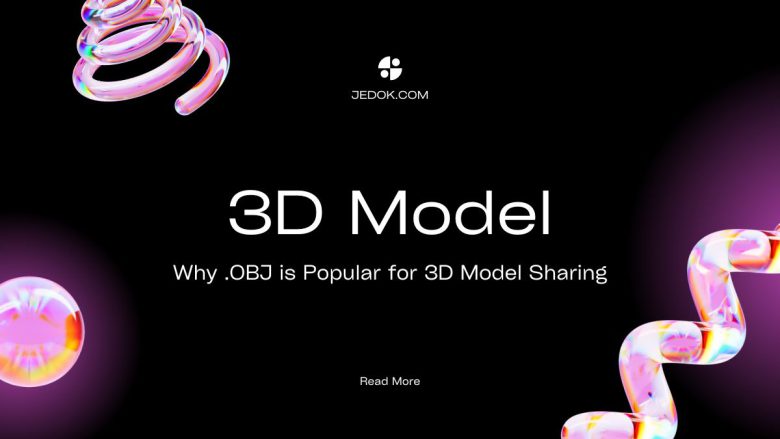
The.OBJ file format has become a standard in the worlds of 3D modeling and computer graphics. It is known for its simplicity, versatility, and compatibility. The OBJ format is commonly used for sharing 3D models across many platforms and apps. This blog post will look at why the.OBJ format is popular for sharing 3D models. It will cover its features, benefits, and uses.
What is the .OBJ File Format?
The .OBJ file format was created by Wavefront Technologies. It is a widely used standard for 3D geometry. An.OBJ file can describe a 3D object’s shape and structure, such as its vertices, edges, faces, and normals. Furthermore, .OBJ files can have texture coordinates and material information. This allows for a more detailed model of a surface.
One of the most distinguishing features of the.OBJ format is its plain text structure. This makes .OBJ files easy to read and edit with a text editor. It creates a high level of transparency and accessibility.
1. Simplicity and Ease of Use
One of the primary reasons for the popularity of the .OBJ format is its simplicity. The format is simple and clear. It is easy to understand. Both new and experienced 3D artists can use it. An .OBJ file’s structure consists of a series of lines. These lines define the model’s geometric elements. They include vertices (v), texture coordinates (vt), and faces (f).
For example, the following lines represent a simple triangular face in an .OBJ file:
v 0.0 0.0 0.0
v 1.0 0.0 0.0
v 0.0 1.0 0.0
f 1 2 3This simplicity allows artists to easily create, modify, and share 3D models without the need for complex software tools.
2. Wide Compatibility
Many 3D modeling programs, rendering engines, and game platforms support the OBJ file format. It is compatible with many applications. This makes it great for sharing 3D models across workflows. You can import and export from Blender, Autodesk Maya, 3ds Max, and other 3D software. You can easily handle OBJ files.
For example, a 3D artist can make a model in Blender. They can then export it as an .OBJ file. This file can be imported into a game engine like Unity or Unreal Engine for more work. This interoperability is critical for collaborative projects and multi-platform workflows.
3. Rich Feature Set
The .OBJ format is simple. But, it offers a rich set of features. These support the detailed representation of 3D models. Key features of the .OBJ format include:
- Geometry Representation: .OBJ files can describe complex geometric shapes, including vertices, edges, faces, and normals.
- Texture Coordinates: .OBJ files can include texture coordinates (uv mapping) to accurately apply textures to the surface of the model.
- Material Information: Using accompanying .MTL files, .OBJ files can specify material properties, such as diffuse, specular, and ambient colors, as well as texture maps.
These features let artists create detailed, good-looking models. The models can be easily shared and used in many apps.
4. Human-readable Format
The.OBJ format is human-readable and editable because it is written in plain text. This transparency enables users to inspect and edit the contents of an.OBJ file using a simple text editor. Artists and developers can adjust geometry, textures, and materials by hand. They don’t need special software.
An artist, for example, can open an.OBJ file in a text editor to fix a misplaced vertex or scale a texture map. This level of control is especially beneficial when troubleshooting and fine-tuning models.
5. Small File Size
The .OBJ format makes small files. They are small compared to other 3D formats. This is especially true for complex models with many details. Because of their compact size, .OBJ files are easier to share via email, cloud storage, and other online platforms. Also, smaller files load faster. They also improve performance when importing models into software.
For example, a game developer can share them effectively. They share OBJ models with team members or collaborators. This process streamlines workflow and boosts productivity.
Practical Applications of the .OBJ Format
The.OBJ format’s versatility and popularity make it appropriate for a wide range of applications in a variety of industries. Here are a few practical applications:
1. 3D Printing
People like the .OBJ format in 3D printing. It can show complex shapes well and supports textures. 3D printers can read.OBJ files and produce precise physical replicas of digital models.
2. Video Game Development
Game developers use .OBJ files to load 3D assets into game engines. The OBJ format is compatible with popular game engines such as Unity and Unreal Engine. This makes it a top choice for making game environments, characters, and objects.
3. Virtual Reality and Augmented Reality
.OBJ files are also used in virtual reality (VR) and augmented reality (AR) applications. It works with many software platforms. This lets developers make immersive VR and AR experiences. They can feature detailed 3D models.
4. Animation and Visual Effects
In animation and visual effects, .OBJ files are used to create and share 3D models. They are used for film, TV, and ads. The format can represent detailed geometry and textures. This makes it ideal for making realistic and appealing animations.
5. Architectural Visualization
Architects and designers use .OBJ files. They use them to make 3D models of buildings and structures. They do this for visualization and presentation. The format’s compatibility with design software allows for seamless integration into architectural workflows.
Tips for Working with .OBJ Files
To make the most of the .OBJ format for 3D model sharing, consider the following tips:
1. Optimize Models
Before sharing .OBJ files, optimize the models by reducing the polygon count and cleaning up unnecessary elements. This improves performance and reduces file size.
2. Include .MTL Files
When sharing .OBJ files, include the accompanying .MTL files that contain material information. This ensures that the textures and material properties are preserved and accurately rendered.
3. Check for Compatibility
Ensure that the software tools you use are compatible with the .OBJ format. Test the import and export functions to verify that the models are correctly interpreted.
4. Use Consistent Naming Conventions
Use consistent naming conventions for vertices, textures, and materials. This will avoid confusion and ensure that the elements are correctly referenced in the .OBJ file.
5. Leverage UV Mapping
Take advantage of the .OBJ format’s support for UV mapping to accurately apply textures to the model’s surface. Proper UV mapping enhances the visual quality and realism of the model.
Conclusion
The .OBJ file format is popular for sharing 3D models. It’s simple, works with many things, has many features, is human-readable, and has a small file size. Its versatility makes it fit for many uses. These include 3D printing, video games, virtual reality, animation, and architecture. The .OBJ format has benefits. Using it and best practices, artists and developers can make, share, and use 3D models in many projects and workflows. The .OBJ format works for both beginners and seasoned 3D pros. It provides a reliable and accessible solution for your 3D modeling needs.


